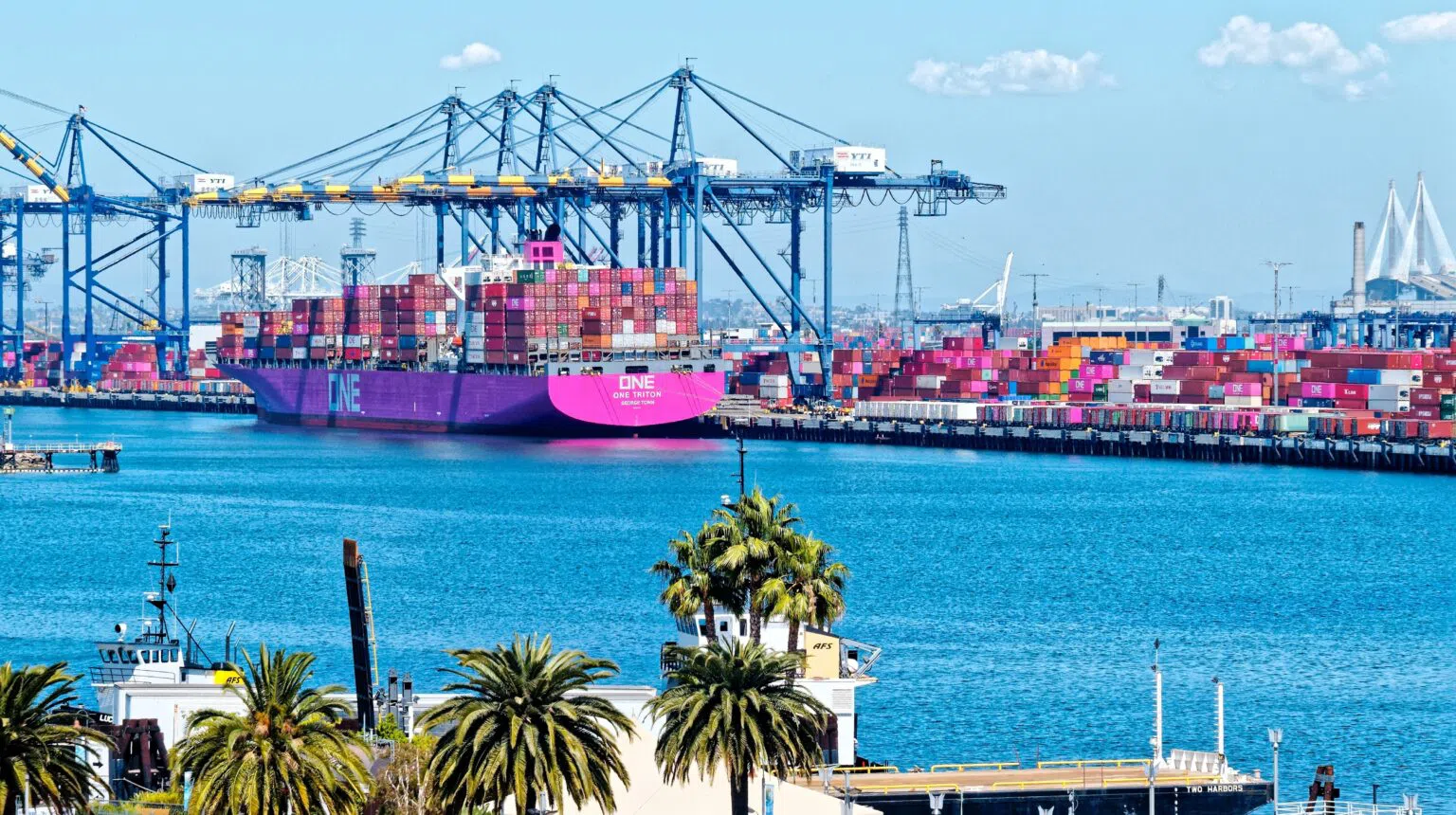Ships at Anchor, Supply Chain Challenges Impact 2021 Air Emissions Inventory
Emissions from port-related sources increased in 2021 compared to the previous year, according to the Port of Los Angeles’ latest Inventory of Air Emissions.
The 2021 results were significantly impacted by a series of supply chain disruptions, particularly cargo vessels anchored outside the port complex.
Over the past year, private and public stakeholders have been successful in reducing congestion and ships at anchor, which will improve 2022 emissions.
Compared with 2020, emissions of diesel particulate matter (DPM), nitrogen oxides (NOx) and sulfur oxides (SOx) increased 56%, 54% and 145% respectively.
Despite significant year-over-year increases since 2020, most long-term clean air gains achieved under the San Pedro Bay Clean Air Action Plan (CAAP) proved resilient.

Emissions of DPM and SOx continue to meet 2023 CAAP goals, with DPM reductions now 84% below 2005 levels, compared to the 77% CAAP goal.
SOx reductions are now 95% below 2005 levels, compared to the 93% CAAP goal. Unfortunately,
The Port expects all of these numbers to improve for the 2022 emissions inventory based on combined stakeholder efforts to reduce these impacts. NOx emission reductions since 2005 no longer meet the 2023 CAAP goal for NOx, as they are now 44% below 2005 levels, compared to the 59% CAAP goal.

“The environmental impact of a congested supply chain was evident last year,” said Port of Los Angeles Executive Director Gene Seroka. “The backlog of ships sitting outside San Pedro Bay was significant.
Fortunately, industry stakeholders took steps in the fourth quarter to reduce at-anchorage vessels to ease the impact on residents and workers in the San Pedro Bay and throughout the South Coast Air Basin.
“We’re working hard to address these issues and improve results,” Seroka added. “We are now providing incentive funding for zero emission trucks, testing a range of new green technologies and working internationally to decarbonize ocean shipping between Los Angeles and China.
At the same time, we’ve reduced the backlog of ships waiting to enter the San Pedro Bay by more than 90% and are partnering with stakeholders on additional measures to improve cargo fluidity.
An efficient supply chain reduces environmental, community and climate impacts.”

Measures implemented in November 2021 by the Pacific Maritime Association, Pacific Merchant Shipping Association and Marine Exchange of Southern California now require ships to slow steam toward the San Pedro Bay and queue 150 miles offshore instead of accumulating outside the breakwater.
This measure has been instrumental in improving safety and reducing emissions from ships in the queue.
At the height of the congestion in January 2022, the Marine Exchange reported 109 vessels at anchor or in holding areas.
As of today, no container vessels are anchored offshore and eight are slow-steaming toward San Pedro Bay, a reduction of more than 90%.
The 2021 inventory shows reducing greenhouse gases (GHGs) continues to be a challenge. GHG emissions are up 39% for the year and 23% since 2005.
Tackling GHGs and eliminating remaining ground-level pollutants hinge on major breakthroughs in efficiency and innovation.
The Port continues to pursue strategies that will lead to the next major breakthroughs.
Its goals include transitioning all cargo-handling equipment to zero emissions by 2030 and all drayage trucks calling at marine terminals to zero emissions by 2035.
Continued state and federal policy and funding support are essential to achieving these goals.

Leading initiatives include:
- Clean Truck Fund: Effective April 1, 2022, the San Pedro Bay ports began collecting $10 per loaded TEU entering or leaving container terminals by truck. ZE trucks are permanently exempt. Low-NOx trucks have a short-term exemption. The money will pay for incentives of at least $150,000 per truck toward purchasing a zero-emissions model to accelerate turnover of the drayage fleet. On September 12, 2022, the Port began distributing vouchers for these zero-emissions trucks. Additionally, the Port plans to bring contracts for the early deployment of up to 42 ZE drayage trucks to the Los Angeles Harbor Commission in the coming months.
- Demonstrations: The Port is leading or participating in 16 regional projects with multiple industry partners to demonstrate near-zero and zero-emissions engines and related fueling or charging infrastructure. These initiatives involve testing trucks and cargo handling equipment that run on electricity, hydrogen fuel and renewable natural gas in real-world operating conditions in and around the Port.
- Green Shipping Corridor: The Port is collaborating with the Port of Shanghai, maritime partners and C40 Cities, a global network of 100 of the largest cities in the world, to decarbonize ocean shipping between the U.S. and China. The initiative aims to create the first green shipping corridor on one of the world’s busiest container shipping routes by 2030.














